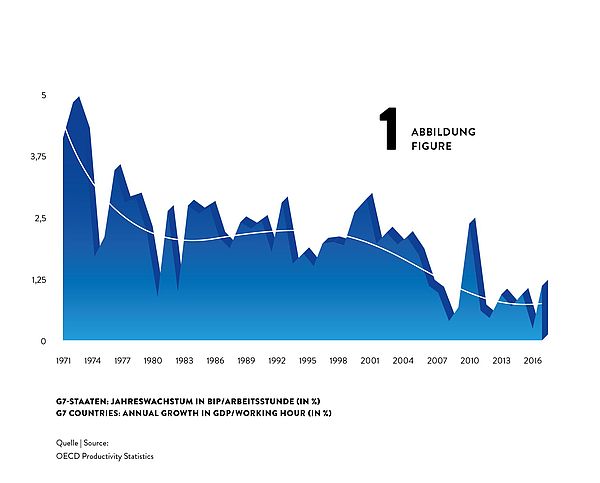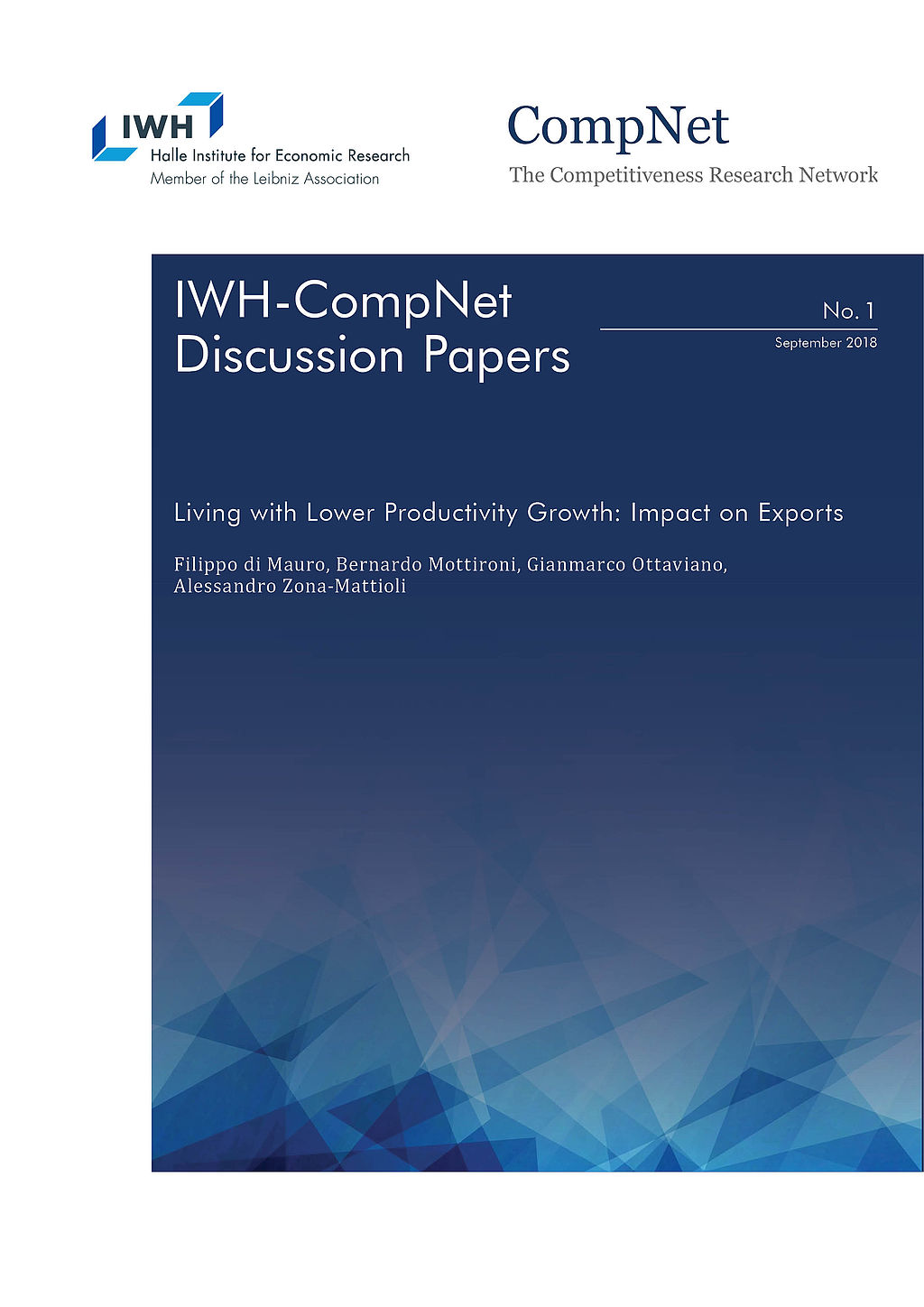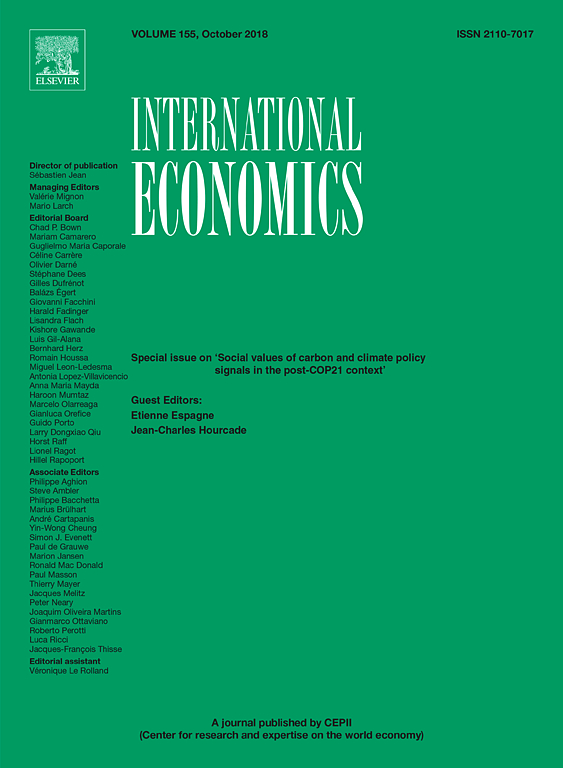Productivity: More with Less by Better
Available resources are scarce. To sustain our society's income and living standards in a world with ecological and demographic change, we need to make smarter use of them.
Dossier

In a nutshell
Nobel Prize winners Paul Samuelson and William Nordhaus state in their classic economics textbook: Economics matters because resources are scarce. Indeed, productivity research is at the very heart of economics as it describes the efficiency with which these scarce resources are transformed into goods and services and, hence, into social wealth. If the consumption of resources is to be reduced, e. g., due to ecological reasons, our society’s present material living standards can only be maintained by productivity growth. The aging of our society and the induced scarcity of labour is a major future challenge. Without productivity growth a solution is hard to imagine. To understand the processes triggering productivity growth, a look at micro data on the level of individual firms or establishments is indispensable.
Our experts

Department Head
If you have any further questions please contact me.
+49 345 7753-708 Request per E-Mail
President
If you have any further questions please contact me.
+49 345 7753-700 Request per E-MailAll experts, press releases, publications and events on “Productivity”
Productivity is output in relation to input. While the concept of total factor productivity describes how efficiently labour, machinery, and all combined inputs are used, labour productivity describes value added (Gross Domestic Product, GDP) per worker and measures, in a macroeconomic sense, income per worker.
Productivity Growth on the Slowdown
Surprisingly, despite of massive use of technology and rushing digitisation, advances in productivity have been slowing down during the last decades. Labour productivity growth used to be much higher in the 1960s and 1970s than it is now. For the G7 countries, for example, annual growth rates of GDP per hour worked declined from about 4% in the early 1970s to about 2% in the 1980s and 1990s and then even fell to about 1% after 2010 (see figure 1).

This implies a dramatic loss in potential income: Would the 4% productivity growth have been sustained over the four and a half decades from 1972 to 2017, G7 countries’ GDP per hour would now be unimaginable 2.5 times as high as it actually is. What a potential to, for instance, reduce poverty or to fund research on fundamentals topics as curing cancer or using fusion power!
So why has productivity growth declined dramatically although at the same time we see, for instance, a boom in new digital technologies that can be expected to increase productivity growth? For sure, part of the decline might be spurious and caused by mismeasurement of the contributions of digital technologies. For instance, it is inherently difficult to measure the value of a google search or another video on youtube. That being said, most observers agree that part of the slowdown is real.
Techno-Pessimists and Techno-Optimists
Techno-pessimists say, well, these new technologies are just not as consequential for productivity as, for instance, electrification or combustion engines have been. Techno-optimists argue that it can take many years until productivity effects of new technologies kick in, and it can come in multiple waves. New technology we have now may just be the tools to invent even more consequential innovations in the future.
While this strand of the discussion is concerned with the type of technology invented, others see the problem in that inventions nowadays may diffuse slowly from technological leaders to laggards creating a wedge between few superstar firms and the crowd (Akcigit et al., 2021). Increased market concentration and market power by superstar firms may reduce competitive pressure and the incentives to innovate.
Finally, reduced Schumpeterian business dynamism, i.e. a reduction in firm entry and exit as well as firm growth and decline, reflects a slowdown in the speed with which production factors are recombined to find their most productive match.
While the explanation for and the way out of the productivity puzzle are still unknown, it seems understood that using granular firm level data is the most promising path to find answers.
What are the Origins of Productivity Growth?
Aggregate productivity growth can originate from (i) a more efficient use of available inputs at the firm level as described above or (ii) from an improved allocation of resources between firms.
Higher efficiency at the firm level captures, e.g., the impact of innovations (Acemoglu et al., 2018) or improved firm organisation (management) (Heinz et al., 2020; Müller und Stegmaier, 2017), while improved factor allocation describes the degree of which scarce input factors are re-allocated from inefficient to efficient firms (‘Schumpeterian creative destruction’) (Aghion et al., 2015; Decker et al., 2021).
Most economic processes influence the productivity of existing firms and the growth and the use of resources of these firms and their competitors as well. The accelerated implementation of robotics in German plants (Deng et al., 2020), the foreign trade shocks induced by the rise of the Chinese economy (Bräuer et al., 2019), but also the COVID-19 pandemic, whose consequences are still to evaluate (Müller, 2021) not only effects on productivity and growth of the firms directly affected but at the same time may create new businesses and question existing firms.
While productivity can be measured at the level of aggregated sectors or economies, micro data on the level of individual firms or establishments are indispensable to study firm organisation, technology and innovation diffusion, superstar firms, market power, factor allocation and Schumpeterian business dynamism. The IWH adopts this micro approach within the EU Horizon 2020 project MICROPROD as well as with the CompNet research network.
As “creative destruction” may also negatively affect the persons involved (e. g., in the case of layoffs, Fackler et al., 2021), the IWH analyses the consequences of bankruptcies in its Bankruptcy Research Unit and looks at the implications of creative destruction for the society, e. g., within a project funded by Volkswagen Foundation searching for the economic origins of populism and in the framework of the Institute for Research on Social Cohesion.
Publications on “Productivity”

Living with Lower Productivity Growth: Impact on Exports
in: IWH-CompNet Discussion Papers, No. 1, 2018
Abstract
This paper investigates the impact of sustained lower productivity growth on exports, by looking at the role of the productivity distribution and allocative efficiency as drivers of export performance. It follows and goes beyond the work of Barba Navaretti et al. (2017), analysing the effects of productivity on exports depending on the dynamics of allocative efficiency. Low productivity growth is a well-documented stylised fact in Western countries – and possibly a reality likely to persist for some time. What could be the impact of persistent sluggish growth of productivity on exports? To shed light on this question, this paper examines the relationship between the productivity distribution of firms and sectoral export performance. The structure of firms within countries or even sectors matters tremendously for the nexus between productivity and exports at the macroeconomic level, as the theoretical and empirical literature documents. For instance, whether too few firms at the top (lack of innovation) or too many firms at the bottom (weak market selection) drives slow average productivity at the macro level has very different implications and therefore demands different policy responses.

The Exchange Rate, Asymmetric Shocks and Asymmetric Distributions
in: International Economics, August 2018
Abstract
The elasticity of exports to exchange rate fluctuations has been the subject of a large body of literature without a clear consensus emerging. Using a novel sector-level dataset based on firm level information, we show that exchange rate elasticities double in size when country and sector specific firm productivity distributions are considered in the empirical estimations. In addition, exports appear to be sensitive to appreciation episodes, but rather unaffected by depreciations. Finally, only rather large changes in the exchange rate appear to matter. The paper intends to contribute to the debate on the effectiveness and impacts of exchange rate movements, which features highly in the policy agenda.

Selection Versus Incentives in Incentive Pay: Evidence from a Matching Model
in: SSRN Working Papers, 2018
Abstract
Higher incentive pay is associated with better firm performance. I introduce a model of CEO-firm matching to disentangle the two confounding effects that drive this result. On one hand, higher incentive pay directly induces more effort; on the other hand, higher incentive pay indirectly attracts more talented CEOs. I find both effects are essential to explain the result, with the selection effect accounting for 12.7% of the total effect. The relative importance of the selection effect is the largest in industries with high talent mobility and in more recent years.

State Enforceability of Noncompete Agreements: Regulations that Stifle Productivity!
in: Human Resource Management, No. 1, 2018
Abstract
Noncompete agreements (also known as covenants not to compete [CNCs]) are frequently used by many businesses in an attempt to maintain their competitive advantage by safeguarding their human capital and the associated business secrets. Although the choice of whether to include CNCs in employment contracts is made by firms, the real extent of their restrictiveness is determined by the state laws. In this article, we explore the effect of state‐level CNC enforceability on firm productivity. We assert that an increase in state level CNC enforceability is detrimental to firm productivity, and this relationship becomes stronger as comparable job opportunities become more concentrated in a firm's home state. On the other hand, this negative relationship is weakened as employee compensation tends to become more long‐term oriented. Results based on hierarchical linear modeling analysis of 21,134 firm‐year observations for 3,027 unique firms supported all three hypotheses.

Differences Make a Difference: Diversity in Social Learning and Value Creation
in: Journal of Corporate Finance, 2018
Abstract
Prior research has demonstrated that CEOs learn privileged information from their social connections. Going beyond the importance of the number of social ties in a CEO's social network, this paper studies the value generated from a diverse social environment. We construct an index of social-network heterogeneity (SNH) that captures the extent to which CEOs are connected to people of different demographic attributes and skill sets. We find that higher CEO SNH leads to greater firm value through the channels of better corporate innovation and diversified M&As. Overall, the evidence suggests that CEOs' exposure to human diversity enhances social learning and creates greater growth opportunities for firms.



